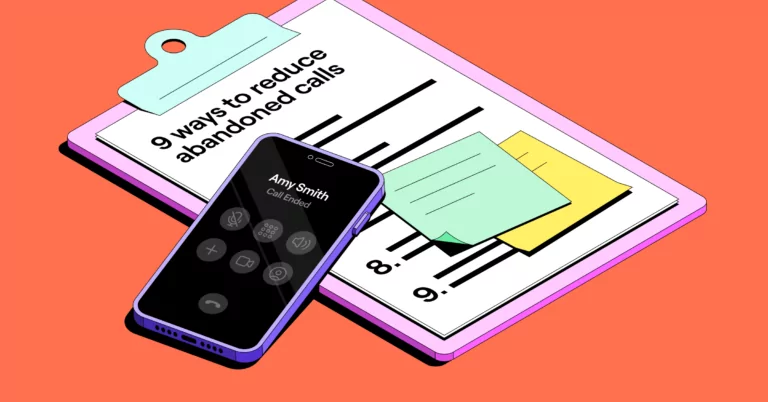An abandoned call is to your small business as an accidental left swipe is to your dating profile — a missed opportunity to build a connection. As a small business, you can’t afford to miss out on potential customer interactions and opportunities to build revenue.
The good news is this challenge also presents a unique opportunity for small businesses to differentiate themselves through superior customer service.
In this article, we’ll get to the bottom of why customers abandon calls and how to solve for each reason — reducing high abandonment rates and boosting retention.
Abandoned calls: Key terms to know
- Abandoned call: Any inbound call someone outside your team initiates, but the caller disconnects before any conversation takes place — either with a live representative or through a voicemail system. This disconnection can happen for various reasons, including long wait times or caller frustration with navigating phone menus.
- Call abandonment rate: A metric calculated by dividing the total number of abandoned calls by the total number of incoming calls within a given time frame — expressed as a percentage. It’s a key performance indicator (KPI) of customer support and satisfaction.
- Abandon time: The duration a caller waits on hold in a call queue before hanging up the call without reaching a customer service representative. This metric is crucial for understanding caller patience thresholds.
- Interactive Voice Response (IVR): A pre-recorded, interactive menu that greets callers and routes them to the appropriate department using voice commands and keypad selections.
- Average speed of answer (ASA): The average amount of time elapsed from the moment a call is received until it is answered by a live rep. This comprises the entire waiting period for the customer, including any time spent navigating an IVR system.
Missed calls vs. abandoned calls: Key differences
There are two critical differences between missed calls and abandoned calls.
| Missed Call | Abandoned Call |
|---|---|
| A call that goes through the IVR and reaches at least one live rep but is sent to voicemail because all reps are busy and not because the caller hung up. | A call where the caller hangs up before it reaches a live rep — usually when listening to a phone menu greeting or after going through a menu option. |
| When a call goes directly to voicemail, but the caller doesn’t leave a message. | When the caller hangs up during a prolonged ring without reaching voicemail or a live representative. |
8 best practices to reduce abandoned call rates
Customers hang up for a variety of reasons. Let’s look at how to eliminate each of them.
1. Keep callers informed while on hold
There’s nothing customers dislike more than waiting for information. In fact, nearly 80% of consumers say they’d prefer getting information from a machine than being put on hold for a long time.
Keeping inbound callers engaged while they wait is an easy fix. Use hold music, provide real-time queue updates, and check back every five minutes. If it’s a busy time of the year, use your IVR menu to set hold time expectations at the beginning of the call.
2. Anticipate business growth spurts
During busy months — the holidays or tax season, for example — callers and businesses face added stress. At this point, your customers are even more likely to get overwhelmed and hang up.
If you have historical data to identify these growth spurts, hire temporary staff so your customer wait times don’t stretch out. Identify triggers such as social media mentions or product launches so you can distribute resources across personnel and technology.
You may also find certain days or times of day when your call volume spikes, in which case you can use analytics to staff as needed. For OpenPhone Business plan customers, you can easily review your analytics to find the busiest times for incoming calls and messages so you don’t miss important calls.
3. Adjust the ring time
In a study by Replicant, 44% of customers said they get angry or irritated by a 5 to 15-minute waiting window — causing them to hang up. To avoid customer frustration, reduce the wait time by shortening the ring duration for each ring group if you’re seeing a large amount of abandoned calls.
You may also find after speaking with colleagues that a phone number doesn’t have adequate coverage, and you may need to add more folks who receive the initial incoming call notifications or additional sets of groups. Internally, this can take the pressure off specific reps.
4. Experiment with call flow
Customers often abandon calls because reps are unavailable to answer. In this case, tweak your call flow. Instead of having calls go to just one person, set up your system so calls are shared among several team members. You can do this through simultaneous ring or sequential routing to manage high call volumes.
OpenPhone users can set up strategic call routing so calls reach the right team members in the right order.
5. Keep your IVR menu simple
Customers get impatient and hang up when an IVR menu is overly complicated.
Keep your IVR script simple and succinct, with no more than five options. Place the most popular options first, and always include an option to speak directly with a representative.
6. Set up auto-replies
When a customer hangs up before they reach a resolution, they’re at their most volatile and impressionable because the peak-end rule effect comes into play. This states that people judge an experience largely based on how they felt at its most intense point (waiting for a response) and at its end (hanging up), rather than on the total sum or average of every moment of the experience.
If you can calm a caller down with a reply after they’ve hung up, you have a higher chance of retaining them. You also have the added benefit of increasing brand visibility and building trust with every customer interaction.
You can take the manual work out of follow-ups with auto-replies. With OpenPhone, you can personalize auto-replies for missed calls without voicemails.
7. Test your call experience
Customers also abandon their calls due to connection errors or technical issues such as poor voice quality. Verify this isn’t the case for your call flow by calling in as a customer and documenting the user experience. If you use a menu, make sure the IVR menu follows proper phone etiquette, feels intuitive, and transitions seamlessly. Also, to improve customer engagement, offer a direct line to a rep if they don’t select a menu option.
8. Adjust staffing according to peak call volume
A study by Zendesk revealed that 72% of customers want to receive service immediately when they need it. And when they don’t get an instant response, they hang up.
Use analytics to track abandoned calls, detect spikes in call volume, and adjust staffing accordingly. For example, if you notice that call volumes are higher on Monday mornings and Friday afternoons, consider hiring temporary staff members for these periods to handle the increased demand.
Get a handle on abandoned calls with OpenPhone
Abandoned calls may look the same on paper, but they represent different frustrations. Use your phone system’s analytics to figure out:
- What makes customers hang up
- Peak abandonment windows
- How you can overcome these challenges
Try OpenPhone free for seven days to reduce your call abandonment rates and make it easier for your team to keep customer calls from slipping through the cracks.

